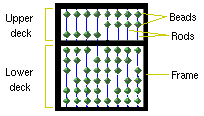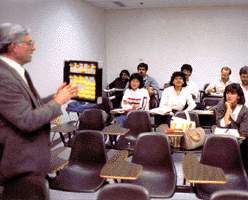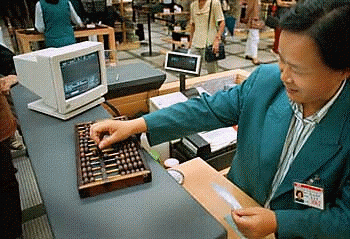| General
information about the Chinese abacus Definition of Bead Arithmetic. Bead Arithmetic is a certain method of reckoning, in which numbers are represented by wooden beads. These beads are systematically arranged on a frame known as the Chinese abacus.The term Bead Arithmetic is used to distinguish it from the other form of arithmetic in which written figures are used. It may be called a science of numbers but, since it is used in daily business life, it is more appropriate to speak of it as an art of reckoning. History. The history of the abacus is very meagre. For reckoning the ancient Chinese used bamboo tallies or chips; the modern Chinese use the abacus. There is no record of who invented the frame, nor is the time known at which this ingenious contrivance made its first appearance. In Dao Nan Tsang's Cease Farming Sketch Book, the terms movable beads frame and sliding beads frame were casually mentioned (Chinese cyclopedia). During the Yuan dynasty in the 14th century the abacus was used. Thus, the abacus was in common use for more than six hundred years ago.
Fig. Anatomy of an abacus Merits of the abacus. In solving any problem in arithmetic, however it may be, two parts of our mental powers must be used, namely, the faculties of computation and of memory. We employ them when we add one and two; for in adding we must first retain the number one in our mind, then we fix our attention upon the other number, two, and finally we compute how much one and two are. With very small numbers these are very simple operations. But as the problems become more complex we soon reach the limit of our mental capacity. In dealing with difficult problems we must find some means by which the memory is relieved of the strain of computation. Fortunate are we that some wise men of past generations did find such means for us. We now merely need to learn how to use them. Among such devices are the bamboo tallies or counters used in ancient times and the Chinese abacus. It is not an automatic machine such as the standard adding machines (in many respects it is superior to such machines) but even so it tenders no little service to us as a memorizing agent in computation. By using this instrument we can devote our entire attention to accuracy in computing and leave the memory work to the frame.
Fig. At school: the teacher demonstrates to how to use the abacus Advantages and Disadvantages of Bead Arithmetic as Compared with Written Arithmetic. Upon comparison, both the Bead and Written or Pen Arithmetic, as it is called in China, have their weak as well as their strong points. In dealing with intricate problems the Pen Arithmetic is indeed more serviceable, but for most of the daily business transactions, Bead Arithmetic is far better suited. Its chief advantage over the pen arithmetic is the economy of time. It is quite safe to say that to solve any problem in the fundamental operations of arithmetic using the abacus, it takes at most half the time that is neede when the written numerals are used. This is especially true in addition. For example, if two men were to solve the same problem in this process, beginning at the same time by using different methods, the result would no doubt be that one could hardly finished copying down the numbers in the question when the other would have obtained the answer already on the frame. Bead Arithmetic, in spite of its superiority, is not without certain disadvantages. With an unskilled operator it is liable to error because the beads are apt to be moved out of place inadvertently. However, this can be guarded against by carefulness. Widespread Use of the Bead Arithmetic. Owing to its advantages the Bead Arithmetic is widely used in China and her neighboring countries. In almost every home throughout the length and breadth of the Celestial Land, the abacus is found. Indeed, in the past dynasties it was the only means by which the Royal Astronomers were able to tell the seasons and the days; the Treasurers of the State to clear the National Accounts, and the common roundheads to transact their business. So important is it considered by the tradesmen in China that they make its use one of their necessary qualifications. In his advertisement, a Chinese merchant never fails to mention: "Only those with fair skill in the abacus need apply". It was early introduced to Japan and Korea and has made a home there. Recently many Westeners have adopted it and have not failed to appreciate its usefulness. If a man values his business time and wants to do twice his usual work he will find in the bead arithmetic a sure means to double his output.
Fig. The use of the abacus in everyday life. Field covered by Bead Arithmetic. Some people seem to consider the Chinese Abacus only as an instrument for addition, or at most for both addition and subtraction. Very fiew have realized that it is not only capable of solving such addition and subtraction problems but multiplication and division also. In fact, it can be used in performing any and every process in Arithmetic. Though in some places, it is rather inconvinient to use the abacus, especially in operations involving complicated fractions, yet even then it is possible. In other places the processes given in Bead Arithmetic are much simpler. For example, in extracting the square and cube roots of numbers, the process is merely a matter of subtraction. As a science, the Bead Arithmetic is not so well developed as the written arithmetic. In the ordinary Chinese book on the abacus considerable attention is given to business and industrial problems, taxes and mensuration. But from the scientific point of view the literature is very meagre. |
Bibliography: -The fundamental operations in bead arithmetic, How to use the Chinese abacus. - Augarten, Stan. Bit by bit An illustrated history of Computers -Ernst, Martin. The calculating machines (DIE
RECHNENMASCHINEN) and their |


